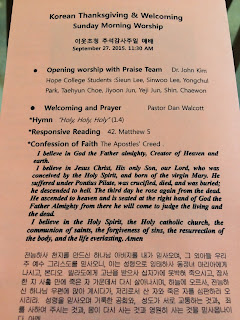Happy Korean Thanksgiving!
Life has gotten a bit crazy the past couple of
Since I am still on a crash-course to learning about Korean-everything, I was curious to learn more about this holiday. We went to Korean church here in Holland to celebrate the day, with an English-version service for all the outsiders who came to celebrate, and then joined a feast of Korean food afterwards.
Later I asked Sang Mark about his memories of Korean Thanksgiving growing up. He said that people usually travel from large cities to their hometowns to spend time with family on this day. Apparently the trip usually takes hours – not because the country is large, but because traffic congestion is so bad in Seoul. (Think of our American Thanksgiving weekend traffic, in a city with 10 million people!)
In Sang Mark’s family, his father had basically raised his 7 younger siblings after their parents died, so everyone came to their house for the holiday. The women (moms and aunts) came a couple of days early to help make the food with Sang Mark’s mom – kind of like how it works in Tanzania before a wedding! I guess it’s easier (and more fun) to make large quantities of good food with people you love, all in one place… instead of everyone making dishes separately and bringing them to a gathering later, as we often do here in the States.
Traditionally, Korean Thanksgiving was meant as a memorial and time of thanksgiving for their ancestors. Since Koreans traditionally believed that a person’s spirit doesn’t die when they die physically, but stays around to protect the descendants, they honored the ancestors (charye) and returned the favor by preparing special foods for them. Sang Mark’s father did insist that they bow down to give thanks to their grandparents who had already passed… but since the rest of the family were strong believers, they immediately turned to worshipping God after this.
I appreciated the way that the Korean pastor explained about this day. He said, “Traditionally, Koreans gave thanks only to our ancestors for the harvest. But as Christians, we give thanks only to God.”
Sang Mark says Thanksgiving was always super fun. He’d come home from school, and everyone was there – all his cousins and aunts and uncles. They ate a lot of food… no turkey, but lots of different kinds of meats like gulbi (a kind of pan-fried fish) and bulgogi (a kind of Korean BBQ using thinly sliced beef). They had lots of different kinds of soups, vegetables like cooked spinach, and a kind of “glass” noodle called japchae. They ate a lot of fruits too, like Asian pears, honey-crisp type apples, and gaum (persimmon). Chestnuts were a part of the day, as well as steamed rice cakes (or songpyeon). Some of these were made with sweetened red beans and honey inside, and some with brown sugar and sesame seeds. I find them a bit bland (then again, I tried a piece alongside a super-sweet Walmart-bought cake!) but SM (and most Koreans, of course) think they’re amazing.
 |
| Japchae Source: rasamalaysia.com |
 |
| Songpyeon Source: BostonChildren'sMuseum.com |
 |
| Source: ReelAsian.com |
With lots of yummy food, games, and time with family – I can imagine why any young boy would enjoy this holiday! We certainly enjoyed our own American version of Thanksgiving with fun family, food, and lots of travel this past weekend... especially as our first major holiday together since being married.


No comments:
Post a Comment